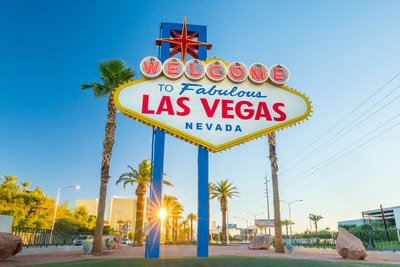
Have you ever wondered which city in the United States has the most sunshine? Perhaps you’re hoping to book a sunny vacation to escape the thick clouds that plague northern parts of the country during the winter and spring. Maybe you’re wondering which areas have the most opportunity for generating solar power. Or perhaps you’re just curious! Either way, we have the answer for you down below.
Our list of the sunniest cities in the US is constructed using NOAA’s National Centers for Environmental Information (NCEI) data. We’ve chosen to rank cities based on the “percentage of possible sunshine.” This metric essentially measures the fraction of time that it could be sunny (i.e., after sunrise and before sunset) when sunshine is actually observed. “Sunshine” in this context means any time that less than 30% of the sky is covered in clouds. It’s not a perfect metric, but it’s one that people have been keeping track of for a long time so we can make reliable comparisons between cities.
Finally, we’re only looking at the sunniest cities with a population of at least 25,000 people, so if your small but sunny town isn’t on the list, that’s probably why.
The 11 Sunniest Cities in the United States
Without further ado, here are the eleven sunniest cities in the US with a population of at least 25,000.
1. Yuma, Arizona
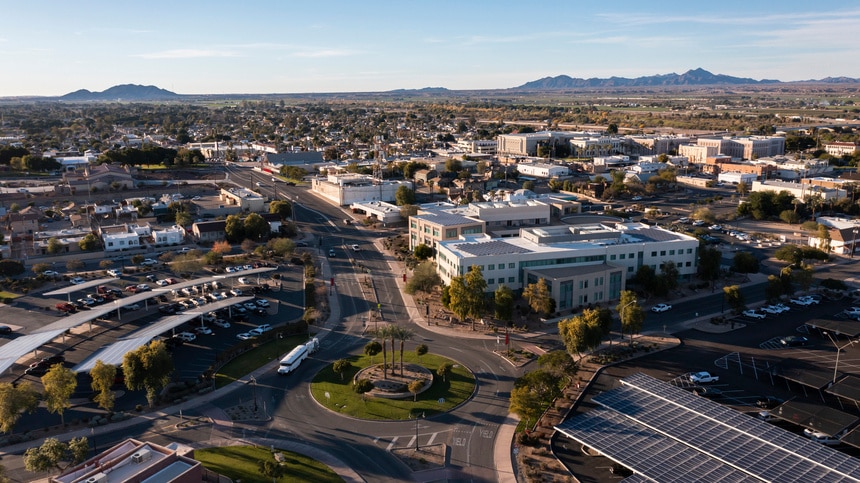
- Average Annual Percentage of Possible Sunshine: 90%
- Average Annual Temperature: 72.7°F
- Average Annual Number of 90°F or Higher Days: 181
- Average Annual Precipitation: 3.3 inches
According to the NOAA, Yuma, Arizona, experiences the most sunny days, making it, without a doubt, the sunniest city in the US. Not only that, it is the sunniest city in the whole world according to the World Meteorological Organization! On average, 90% of hours that could be sunny each year do have clear skies in Yuma.
The city’s main advantage is that it sits squarely in the middle of the North American Desert, an arid swath of land extending from the southwestern United States into Mexico. Like most others in the world, this desert sits around 20 to 30 degrees of latitude away from the equator, where the air that rises in tropical thunderstorms tends to sink back toward the ground. This sinking motion, known in meteorological circles as the descending branch of the Hadley cell, suppresses clouds and precipitation.
Why does Yuma beat out other southwestern cities like Phoenix, Tucson, and El Paso? That answer lies in a summertime phenomenon known as the North American Monsoon. Each year, usually in June, a sprawling high-pressure system that keeps the Desert Southwest warm and dry begins shifting eastward. That allows moisture from the Gulf of Mexico and the tropical Pacific to migrate west and north towards Arizona, California, and New Mexico. This moisture usually must be wrung out by thunderstorms that like to form over mountains.
While mountains are generally not in short supply across the Desert Southwest, Yuma sits on flat land near the northern edge of the Gulf of California. That means it doesn’t usually cash in on monsoon thunderstorms (and their associated clouds) during the summer while remaining just as sunny as the rest of the region during the winter. That combination puts Yuma solidly in first place on our list.
Being at a relatively low elevation in the heart of the desert, Yuma is hot! It averages 181 days yearly above 90°F, and the average high temperature in June, July, August, and September is over 100°F! As a result, the best time to visit is during the winter when temperatures are milder. Yuma is most well-known for the Yuma Territorial Prison State Historical Park, the site of a well-preserved prison from the Wild West days. In the winter, golf and hiking are other popular activities. It’s best to stick to the city’s restaurants and shops in the summer.
2. Redding, California
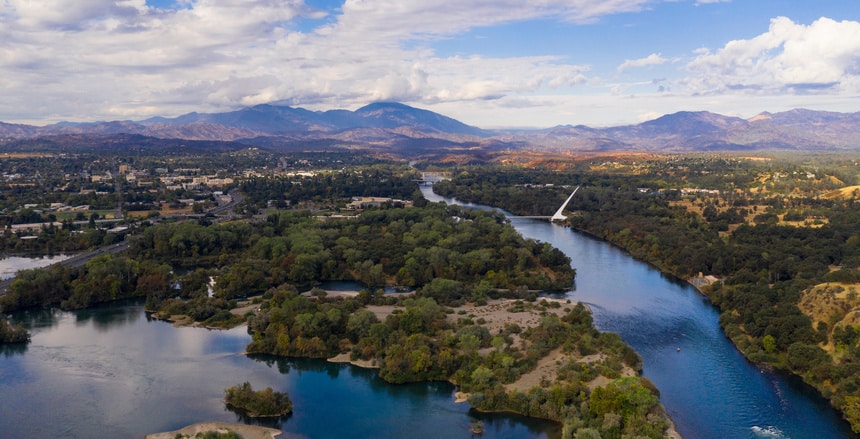
- Average Annual Percentage of Possible Sunshine: 88%
- Average Annual Temperature: 59.8°F
- Average Annual Number of 90°F or Higher Days: 105
- Average Annual Precipitation: 33.5 inches
Redding is the second sunniest place in the United States thanks to its position in California’s Central Valley. Located between two mountain ranges, the craggy Coastal Range to the west and north and the towering Sierras to the east, Redding gets to enjoy a whole lot of sunshine thanks in large part to a process known as downsloping.
When air is forced to descend a mountain, it warms up and dries out, suppressing clouds and precipitation. Mountains surround Redding on three sides—west, north, and east—so it must descend en route into town unless the wind comes out of the south (this is quite rare). It is the main reason Redding can stay sunnier than most other cities in California during the winter when storms often impact the state.
Redding is also relatively far from the Pacific Ocean, an essential source of cloudiness in the summer. Fog can form when warm air moves over the Pacific’s cold water. This often happens during the summer, and it’s the primary reason coastal Californian cities like San Francisco, Los Angeles, and San Diego don’t make this list.
Despite all the sunshine, Redding isn’t all that hot, with an average annual temperature of 59.8°F. That relatively cool average temperature is mostly because winters can be on the cooler side. Redding can get plenty hot in the summer, with 105 days each year topping out over 90°F. With plenty of sunshine throughout the year, Redding also makes our list of cities with the best weather in the US.
Are you thinking of making a trip out to Redding for some sunshine? The city’s Turtle Bay Exploration Park includes an arboretum, botanical gardens, and a museum with natural history exhibits. The Sundial Bridge is a suspension bridge that crosses the Sacramento River. It also acts as a huge, working sundial. Redding is also a great jumping-off point for Lassen Volcanic National Park and Mount Shasta, each about an hour’s drive from the city. Spring and Fall are the best times to enjoy Redding’s sunny skies without too much heat or rain.
3. Las Vegas, Nevada
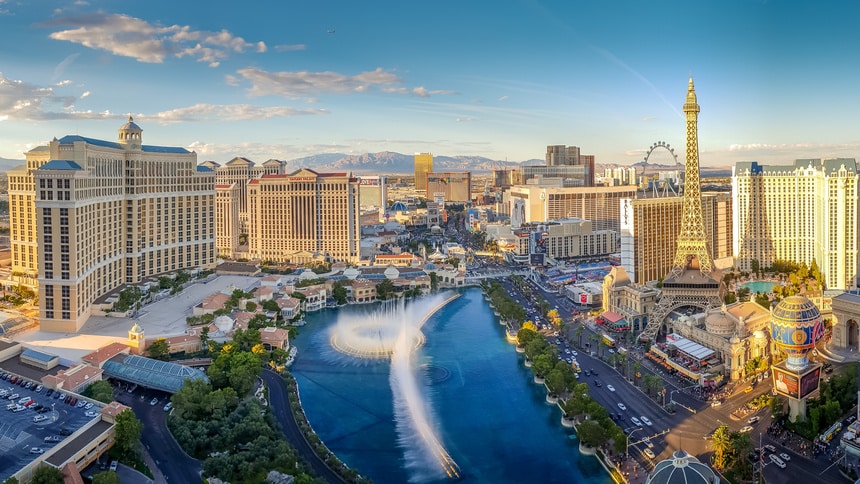
- Average Annual Percentage of Possible Sunshine: 85%
- Average Annual Temperature: 68.3°F
- Average Annual Number of 90°F or Higher Days: 135
- Average Annual Precipitation: 4.2 inches
Las Vegas brings us back to the heart of the Desert Southwest for spot number three. Much like Yuma, Las Vegas enjoys plentiful sunshine thanks to the semi-permanent sinking motion associated with the large subtropical high-pressure system that sets up shop nearby for much of the year. During the winter, storm systems can sometimes approach from the north with strong winds, colder air, and cloudier skies. This sunny city even averages 0.2 inches of snow each year!
It’s all about the heat in the summer, with 135 days above 90°F on average. The city’s average high temperature in July and August is over 100°F! The summer can also bring some action from the monsoon we discussed earlier, with severe thunderstorms and dust storms becoming somewhat common later in the summer.
Do I really need to tell you why people go to Vegas and what they do there?
4. Phoenix, Arizona
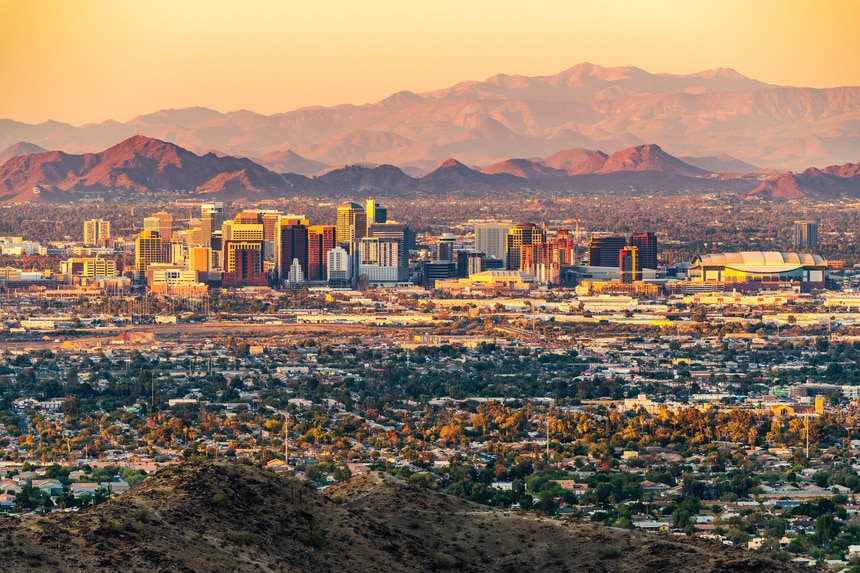
- Average Annual Percentage of Possible Sunshine: 85%
- Average Annual Temperature: 75.0°F
- Average Annual Number of 90°F or Higher Days: 169
- Average Annual Precipitation: 7.2 inches
Phoenix continues the Desert Southwest theme in spot number four. Located in a valley in the central part of the state, Phoenix enjoys a bit of Redding’s downsloping advantage mixed in with its general sunny tendencies in the middle of the desert.
Why, then, is Phoenix in spot number four rather than number one? It’s all about that summer monsoon which produces almost daily showers and thunderstorm activity near the city from mid-June through late August. Phoenix is somewhat known (at least in meteorological circles) for its dust storms, nicknamed “Haboobs.”
Phoenix is not just among America’s sunniest cities. It’s also among the warmest cities in the US! Phoenix gets extremely hot in the summer, with 169 days yearly above 90°F on average and four months of average high temperatures above 100°F.
Phoenix is a great place to enjoy hiking, biking, golf, and nightlife, but be sure to visit outside the peak summer heat unless you’re prepared to endure temperatures well over 100°F day after day! If it is too toasty, the city has a great indoor Botanical Garden and plenty of air-conditioned shops.
5. Tucson, Arizona
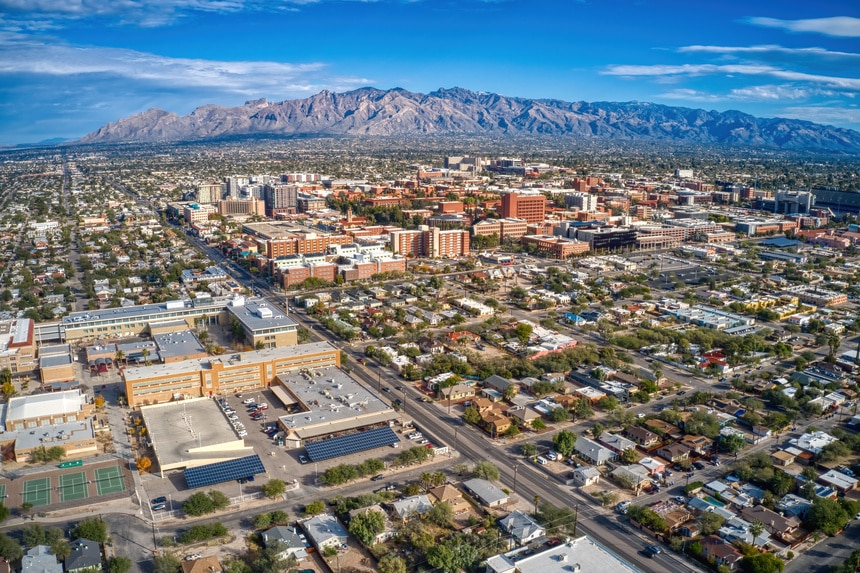
- Average Annual Percentage of Possible Sunshine: 85%
- Average Annual Temperature: 69.2°F
- Average Annual Number of 90°F or Higher Days: 147
- Average Annual Precipitation: 10.6 inches
Just one hundred miles southeast of Phoenix and also located on the valley floor, it is no surprise that Tucson has a nearly identical share of potential sunshine. During the winter, the city enjoys being south of the prevailing storm track, much like Phoenix, Yuma, and the other southwestern cities on the list.
The summer monsoon keeps Tucson out of the top three, and the city’s location a bit east of Phoenix puts it just one spot lower on the list. Remember: monsoon moisture is most abundant as you head east, closer to the Gulf of Mexico. That’s why Tucson receives just a bit more action than Phoenix and a whole lot more than Yuma!
Tucson is known for its food and shopping—no surprise, given that it’s also scorching during the summer! An average year brings 147 days above 90°F and no shortage of triple-digit readings. Heading down to Tucson in the milder winter months, or are you ready to brave the heat outside? If so, check out Saguaro National Park, less than an hour from downtown, with abundant namesake cacti!
6. El Paso, Texas

- Average Annual Percentage of Possible Sunshine: 84%
- Average Annual Temperature: 64.5°F
- Average Annual Number of 90°F or Higher Days: 108
- Average Annual Precipitation: 8.8 inches
On the eastern edge of the North American Desert sits the sixth sunniest city in the United States—El Paso, Texas. Are you noticing a theme yet in our list? That same subtropical high-pressure system that protects Arizona and Nevada from clouds also extends to western Texas. Why, then, is El Paso number six rather than number one? Can you guess?
It’s the monsoon! Unlike Arizona or New Mexico, no mountain ranges stand between the Gulf of Mexico and El Paso. That means that thunderstorms are a fairly regular occurrence in the late spring and summer, tacking on a few more cloudy days while its neighbors to the west remain clear.
El Paso has some great hiking opportunities in the nearby Franklin Mountains, as well as abundant, delicious food and lively nightlife. If you’re looking to take a stroll without getting roasted, late Fall and early winter is the best time. Spring also has cooler temperatures but can bring ferocious wind storms along with blowing dust.
7. Fresno, California
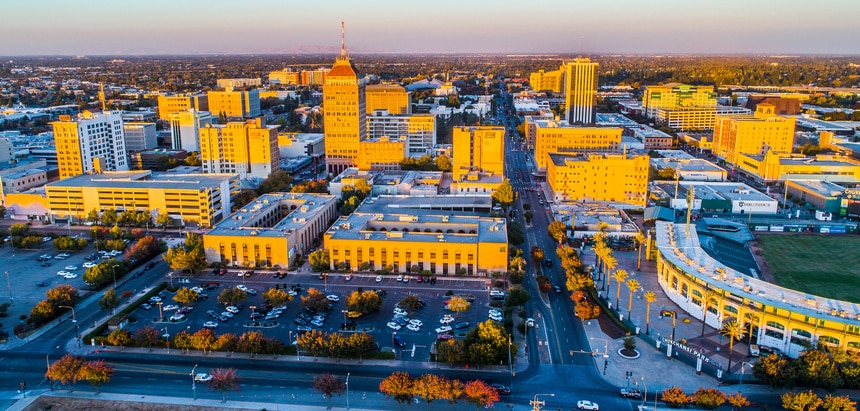
- Average Annual Percentage of Possible Sunshine: 79%
- Average Annual Temperature: 64.3°F
- Average Annual Number of 90°F or Higher Days: 108
- Average Annual Precipitation: 11.0 inches
Located in California’s Central Valley, Fresno shares many attributes that bring Redding into our top eleven list of sunniest cities. It’s near the valley floor and surrounded by mountains to the west, east, and (albeit farther away) south. That means it benefits from plenty of downsloping when winter storms roll through. It’s also a bit too far west to see much of the monsoon that brings most of the Desert Southwest’s rain, though sometimes a few stray thunderstorms can pop up over the nearby Sierras during the summer.
Fresno has a few well-known tourist attractions if you’re looking for some fun in the sun. Woodward Park has a beautiful Japanese Garden, and the Fresno Zoo has a reputation as being one of the better zoos in interior California. Had a bit too much sun? Forestiere Underground Gardens offers the chance to get some local history and culture below ground. Fresno is also a common jumping-off point for Yosemite National Park with its famous granite formations and impressive waterfalls.
8. Reno, Nevada
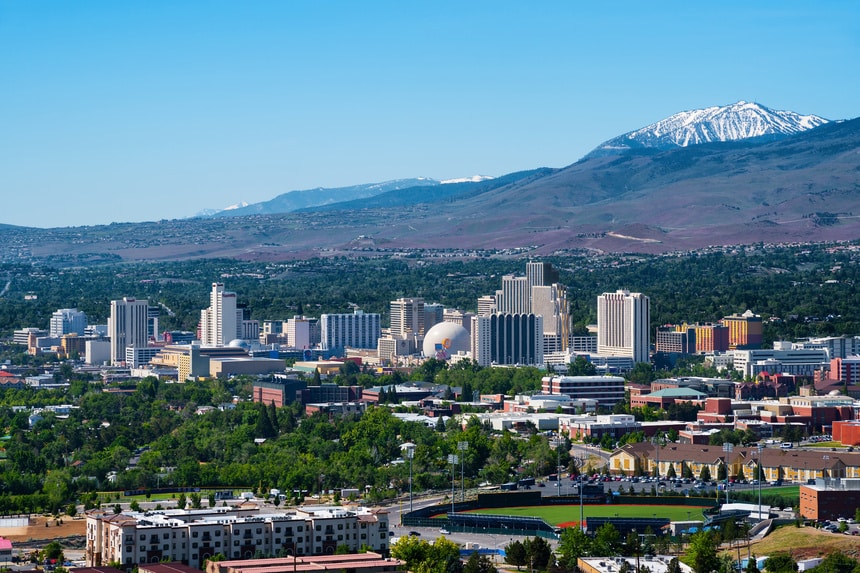
- Average Annual Percentage of Possible Sunshine: 79%
- Average Annual Temperature: 53.7°F
- Average Annual Number of 90°F or Higher Days: 56
- Average Annual Precipitation: 7.4 inches
Reno sits on Nevada’s western edge, just a few miles from the California border. More importantly, for our purposes, it sits just east of the towering Sierra Nevada. Why is that important? When powerful storms known as Atmospheric Rivers slam into California, dropping heavy rain in the valleys and feet upon feet of snow in the mountains, the air involved has to do a lot of descending before it gets to Reno. That helps keep the city much brighter (and drier) than its peers to the west.
Like almost all of Nevada, Reno is also considered part of the North American Desert. It’s a bit far northwest to see the core of the monsoon during the summer, but it is much closer to the storm track during the winter than most other southwestern towns we’ve been discussing, which is why it’s only in spot number eight. Despite all the sunshine, Reno isn’t especially hot, with an average temperature of 53.7°F and only 56 days each year above 90°F.
Reno isn’t really known as a tourist destination, except among Northern Californians, for whom it is the closest place to play casino games. It is very close to beautiful Lake Tahoe, though!
9. Flagstaff, Arizona
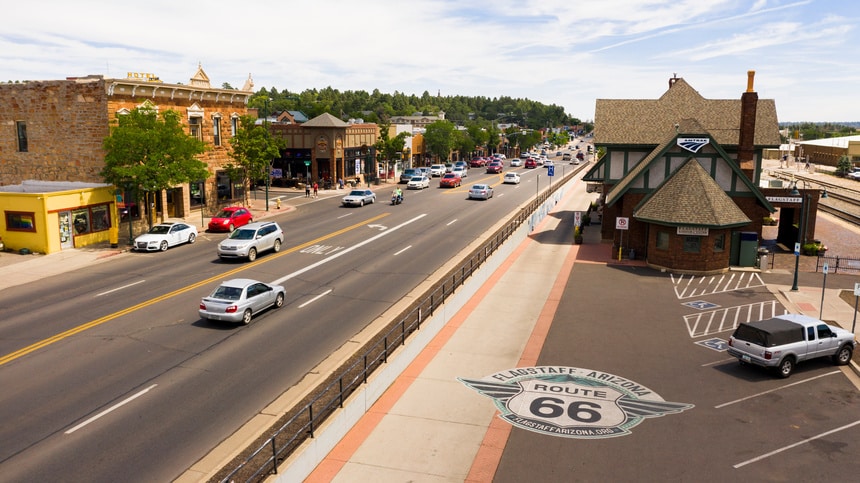
- Average Annual Percentage of Possible Sunshine: 78%
- Average Annual Temperature: 46.2°F
- Average Annual Number of 90°F or Higher Days: 3
- Average Annual Precipitation: 20.5 inches
Back in the heart of the Desert Southwest, Flagstaff comes in at spot nine on our list of the country’s sunniest cities despite its much higher elevation and cooler/wetter climate compared to most of the rest of Arizona. Flagstaff sits under the same high-pressure system as Phoenix for much of the year. In winter, though, air approaching the city is forced to rise nearly 6,000 feet from the valley floor, cooling as it goes. That cooling leads to condensation and, quite often, precipitation which helps make Flagstaff perhaps counterintuitively one of the nation’s snowiest cities! In the summer, that same rising air helps fuel monsoon thunderstorms that can also provide a bit more cloud cover despite Flagstaff’s general desert sunniness.
While sunshine is plentiful in Flagstaff, especially during the spring and Fall, it’s not particularly hot. The town averages just three days over 90°F each year! That’s significantly less than any other city on our list. Are you excited to enjoy some sunshine without the scorching heat? Flagstaff is a hub for outdoor activities, including hiking and mountain biking. Just north of the city is the world-famous Grand Canyon, with abundant hiking opportunities, horseback riding, and whitewater rafting. If you’re ever in town, stop by Macy’s for one of the best cups of coffee you’ll ever have.
10. Sacramento, California
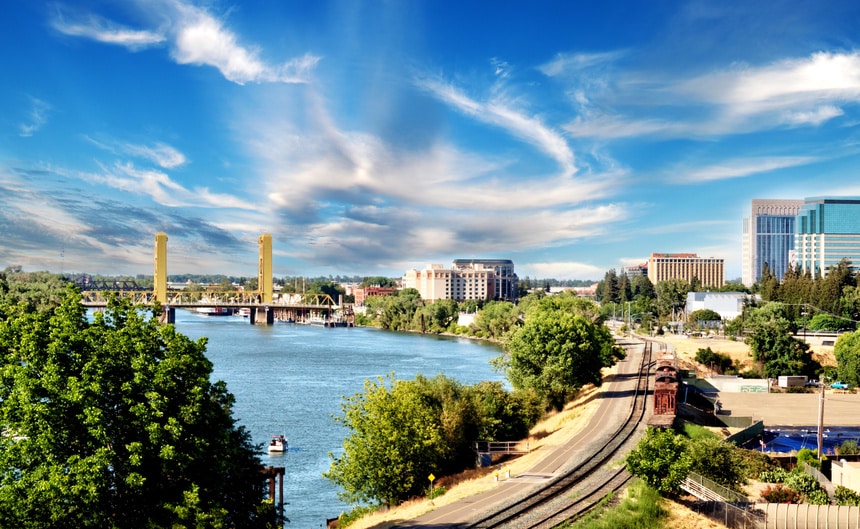
- Average Annual Percentage of Possible Sunshine: 78%
- Average Annual Temperature: 61.0°F
- Average Annual Number of 90°F or Higher Days: 74
- Average Annual Precipitation: 18.0 inches
Almost halfway between Redding and Fresno lies Sacramento, the capital of California. Like the other Californian cities on our list, Sacramento is one of the sunniest places in the US thanks to the winter downsloping and summer fog avoidance afforded by the San Joaquin Valley. It’s lower on the list than the other nearby sunny cities because it sits just east (downwind in the winter) of a gap in the Coastal Range near San Francisco. That allows just a bit more moisture, and cloud cover, to make its way inland during atmospheric river events.
Sacramento is home to numerous historical sites and museums commemorating California’s famous gold rush, for which Sacramento served as a base camp. One of the best museums is the California State Railroad Museum which tells the story of the Transcontinental Railroad, which ran through the city.
11. Albuquerque, New Mexico
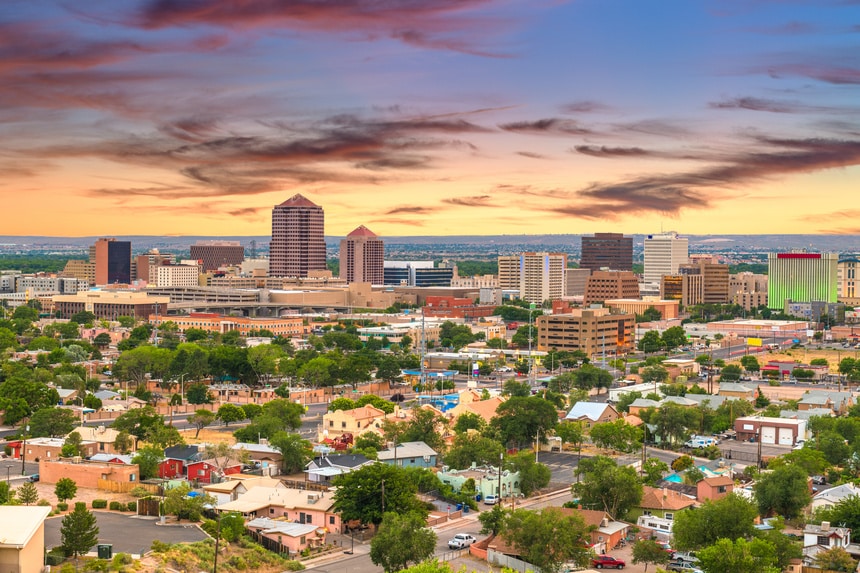
- Average Annual Percentage of Possible Sunshine: 76%
- Average Annual Temperature: 57.1°F
- Average Annual Number of 90°F or Higher Days: 64
- Average Annual Precipitation: 8.9 inches
Albuquerque rounds out our list at number eleven, with an average of 76% sunshine each year. Just north of El Paso, Albuquerque also sits near the eastern edge of the North American Desert and experiences significant monsoon thunderstorm action during the late spring and summer. In the spring and Fall, though, Albuquerque is as sunny as anywhere else in the Desert Southwest. It is often clear in the winter, too, though it’s just far enough north to occasionally get in on the winter storm action that delivers nearby Colorado’s famous snow.
Final Thoughts
The sunniest cities in America are exclusively in the country’s southwestern corner. It’s hardly a surprise given that most of the southwest is part of the North American Desert, and deserts are—dry and sunny. Arizona generally takes the cake for clearest skies, though California’s Central Valley leverages its surrounding mountains to earn spots on the list despite being closer to strong winter storms.
While many of these sunny cities are also known for extreme heat, sunshine doesn’t always translate to high temperatures. Flagstaff, for instance, is fairly cool in the summer and downright cold in the winter.
This list is compiled using data from the National Centers for Environmental Information’s Comparative Climatic Dataset. This dataset uses information spanning from the late 1940s or early 1950s (depending on the station) until 2020, ensuring a long period of reliable data with which to make comparisons. However, for the average temperatures included in this list, we only used averages from 1981-2010, one of the most current thirty-year climate periods. This allows us to include the influence of climate change in our analysis. Precipitation averages are taken from Extreme Weather Watch, which compiles a variety of weather statistics.




